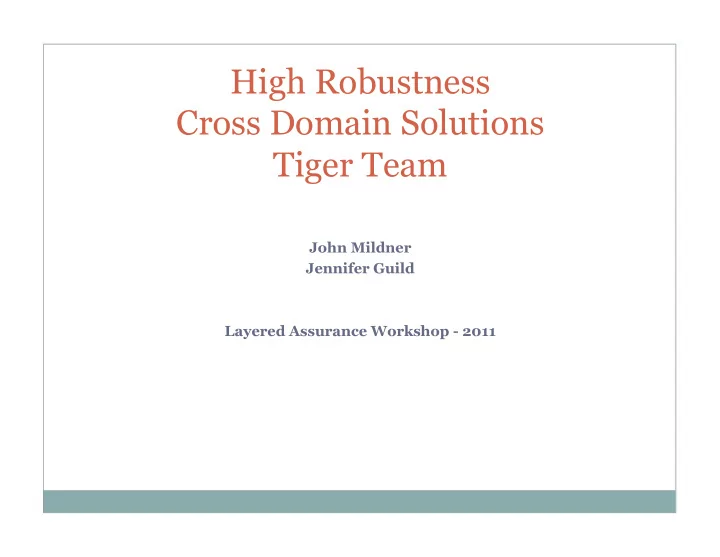

High Robustness Cross Domain Solutions Tiger Team John Mildner Jennifer Guild Layered Assurance Workshop - 2011
Purpose 2 Provide an overview of the High Robustness Cross Domain Solutions Tiger Team (HR CDS TT) Provide status on support to NIST SP 800-53 development
Definitions 3 Robustness is the measure of confidence that a system operates as required, designed, and expected throughout its lifecycle ensuring essential services, coping with faults, failures, unexpected interactions and malicious activities High Robustness provides the technical infrastructure to enable survivability and mission integrity in high threat environments. For CDS, High Robustness reduces risk associated with information sharing across a wide range of domains High Robustness is achieved through design, engineering, and implementation practices throughout the system lifecycle Provides the means to improve current best commercial practice
High Robustness is Critical to CDS –Today’s Reality 4 Information sharing across domains will only increase Threat agents operate within the domains Potential for security policy violations with catastrophic results System complexity increasing (weakest link paradigm applies) Commercial products are typically low or medium robustness Desire for network visibility of CDSs (target) Centralization (known locations) Remote management and monitoring Feedback to low-side senders Increasing data complexity and throughput High robustness will reduce the risk associated with the modern net-centric environment
HR CDS TT Formation 5 Tiger Team formed under the Community Security Test Group (CSTG) to understand how High Robustness can reduce security and programmatic risk in emerging technologies Understand high robustness relationship to CDS design Hardware and software implementation Operating Systems (NIAP policy concern) Emerging technologies (e.g., Separation Kernels) Supports validation of advertised capabilities of CDS products Provide community education (developers, evaluators, consumers, integrators, approvers)
Definitions 6 System = Foundation + Non-Kernel Security Related Functionality The Foundation is the hardware, firmware, and the kernel components that implement a set of security mechanisms only accessible via kernel interface. The Non-Kernel Security Related Functionality (NKSR) makes or enforces policy decisions or operate correctly to maintain data correctness and supports either an interface to the foundation or an interface to applications.
Non-Kernel Security Related Definitions 7 NKSR can be further refined into functions that interface to the foundation (NKSR-Kernel) and those functions that interface to the applications (NKSR-Application). NKSR-Kernel supports an interface to the foundation and supports/ enforces system security policy or operates correctly to maintain data correctness at the root/admin privilege level. NKSR-Application supports an interface to applications and supports/ enforces application policy decisions or operate correctly to maintain data correctness. NKSR-Application may include security-related applications.
Definition of Levels 8 Robustness Foundation NKSR-Kernel NKSR-App Low Low Low Low Low Medium Low Low Low Medium Low-Medium Low Medium Medium Medium-Low Medium Low Low Medium Low Medium Medium Medium Low Medium-Medium Medium Medium Medium Medium High Medium Medium Medium High Medium-High Medium High High High-Medium High Medium Medium High High Medium High Medium High High-High High High High
Robustness Criteria 9
Development Security ¡Problem Representation 10 Security ¡ Security ¡Policy Objectives System ¡Security ¡ Security ¡ Security ¡ Policy ¡Model Architecture Requirements Security ¡ Functional FTLS Specification High ¡Level ¡Design corresponds ¡to Low ¡Level ¡Design DTLS Source Target is ¡derived ¡from Source Target Implementation ¡ Representation High ¡ Covert ¡Channel ¡ Implementation Robustness Analysis
Accomplishments 11 Developed draft framework document that provides: Definition of levels of robustness (Medium, Medium-High, and High) Definition of the High Robustness architecture (Foundation, Kernel and Application) Identified and defined development assurance artifacts (e.g.): Security Problem and Security Objectives High Level Design Low Level Design Identified 800-53 controls essential for operating system evaluation
Further Research 12 Finalize assurance artifacts: Further define high robustness relationship to: Configuration management, static and dynamic code review, supply chain, etc. Develop and promulgate community education plan Define strategy for efficient evaluation of medium and high robustness CDSs
NIST SP 800-53 Rev 4 13 Being led by Ron Ross Appendix E being transformed to address “Trustworthiness” New Security Controls (such as acquisition artifacts) Linkage to SP 800-37, SP 800-39, and future SP 800-xx (Security Engineering) Coordination draft expected early 2012. 03/05/09
Questions? 14
Recommend
More recommend